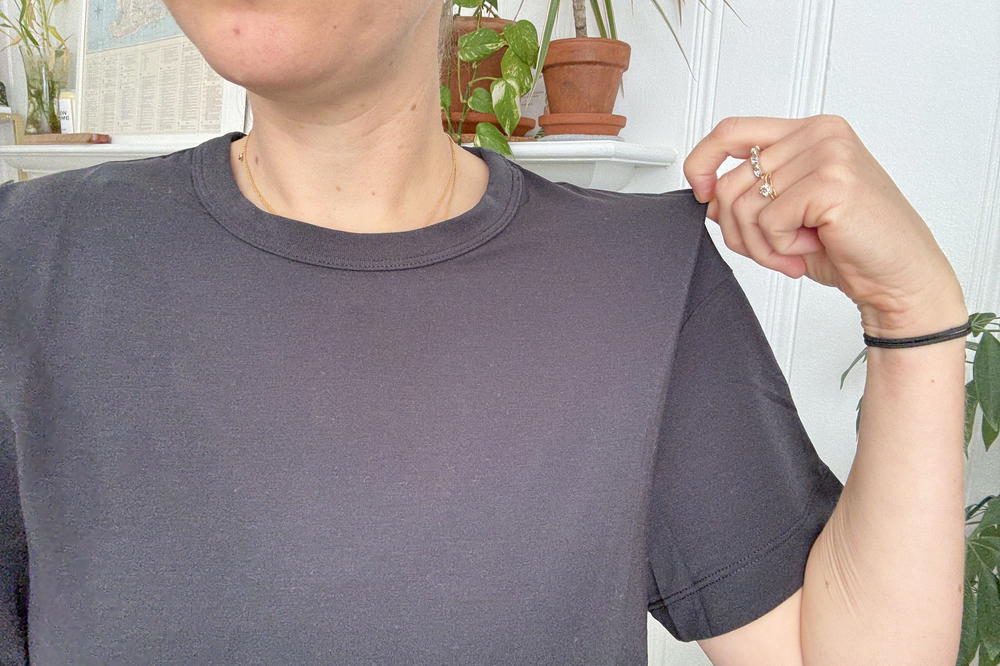Travel Sweaters Review Criteria

See how we score travel sweaters across detailed criteria with weighted ratings.
This article may contain affiliate links. We earn a small commissions when you purchase via those links — and it's free for you. It's only us (Becca & Dan) working on this website, so we value your support! Read our privacy policy and learn more about us.
Table of contents
- Scoring Overview
- Comfort against skin (14%)
- Fit, mobility & sizing accuracy (12%)
- Materials, care requirements & durability (10%)
- Breathability & moisture management (10%)
- Temperature regulation (12%)
- Stretch & shape retention (8%)
- Functionality & layering practicality (6%)
- Wrinkle resistance & packability (6%)
- Durability & knit quality (8%)
- Styling versatility (10%)
- Overall value for price (4%)
- Related Reviews
- Where to go next
This page details the specific criteria we use when reviewing travel sweaters. Each criterion has a weight that contributes to the overall score. Learn more about how our scoring system works.
Scoring Overview
Each criterion below is weighted as a percentage of the total score. We evaluate each product on a scale of 1 to 5 for every criterion, then multiply by the weight to calculate the final rating.
Comfort against skin (14%)
Can you wear this all day without wanting to take it off? I’m evaluating wool softness versus prickle factor, especially for merino. I’m checking seam placement and flatlock stitching quality, particularly on raglan or saddle shoulders where seams can irritate. I’m testing fabric mobility to see if it grabs or glides across other layers. I’m also assessing neckline comfort across crew, mock, full zip and v-neck styles. Merino gets extra scrutiny here since it’s marketed specifically for travel comfort.
Fit, mobility & sizing accuracy (12%)
Sweaters vary more than hoodies in how they fit after wear and wash. I’m evaluating shoulder fit and mobility since sweaters can restrict reach. I’m checking body length accuracy and comparing stretch fit versus structured fit. I’m testing post-wash sizing shift, which is common with wool. The question is whether the piece lines up with the size chart and accommodates different builds after real use.
Materials, care requirements & durability (10%)
Sweaters require more care than hoodies, so this category matters. I’m evaluating fiber composition, comparing pure merino versus blends versus recycled options. I’m testing odor resistance, which is huge for multi-day wear. I’m checking pilling resistance and dry time after hand-washing. I’m assessing shrink potential. I’m also evaluating knit quality and seam durability since sweaters are prone to pilling, snags and seam stretching. We’re generous with care since we typically don’t put things in the dryer, but the care requirements still factor into the score.
Breathability & moisture management (10%)
Sweaters vary dramatically from ultralight merino to heavy cotton blends. I’m comparing fabric thickness versus airflow. I’m testing moisture wicking, especially for merino. I’m evaluating heat management in active scenarios like city walks and hikes. The question is how the fabric vents during movement and whether it handles sweat without feeling sticky.
Temperature regulation (12%)
Travel sweaters should shine in the 50 to 75 degree range. I’m evaluating comfort range from cool mornings to warm afternoons. I’m testing ability to handle microclimate shifts from airport to outdoors to restaurant. I’m checking wind resistance, which is weaker in knit garments than structured layers. Temperature performance is a core selling point for travel sweaters, so this gets weighted accordingly.
Stretch & shape retention (8%)
This is critical for sweaters. I’m checking elbow bagging resistance. I’m testing hem and collar elasticity retention over time. I’m evaluating recovery after compressing inside a backpack. I’m assessing long-term silhouette stability. Poor shape retention ruins sweaters fast, so this matters more than it does for structured garments.
Functionality & layering practicality (6%)
Most sweaters have few or zero pockets, so I’m evaluating what actually matters. If pockets exist, I’m checking depth, bounce resistance and closures. If no pockets, I’m testing hand feel, layering friendliness and under-jacket usability. The question is whether this sweater works as a practical travel layer, not whether it has features it shouldn’t have.
Wrinkle resistance & packability (6%)
I’m comparing packability and compression friendliness. I’m testing wrinkle recovery speed. I’m evaluating resistance to fold creasing, since cotton blends crease more than merino. Merino performs extremely well here, so I’m scoring how well this specific sweater handles being stuffed into luggage and how quickly creases fall out.
Durability & knit quality (8%)
Sweaters are prone to pilling, snags, seam stretching and abrasion wear from bags. This deserves its own scoring bucket. I’m evaluating pilling resistance over time. I’m checking snag resistance and how well the knit handles rough surfaces. I’m testing seam durability, especially at stress points. I’m assessing abrasion resistance where backpack straps or bag handles rub. This is separate from materials and care since it focuses on long-term wear patterns.
Styling versatility (10%)
Sweaters don’t go to the gym, so I’m evaluating travel to casual to smart casual flexibility instead. I’m testing layering with jackets and coats. I’m checking color palette usefulness. I’m assessing minimal branding and refined silhouette. This is a top scoring category for sweaters since styling versatility is often why people choose sweaters over hoodies.
Overall value for price (4%)
Where does this land on price versus what you’re actually getting? I’m evaluating fiber quality versus cost, comparing 16.5 to 19.5 micron merino grades. I’m assessing longevity expectation since cheap merino pills quickly. I’m checking ethical sourcing, which is especially important in merino. I’m weighing care requirements relative to price. The question is whether the quality and durability justify the cost compared to competing options.
Related Reviews
Here are our reviews of travel sweaters that use these scoring criteria:
- PAKA Men's Ultralight Crew Sweater Review: Built to Last
- Pladra Women's Jenner Sherpa Fleece Review: Cozy Teddy-Style Layer
- Cotopaxi Women's Abrazo Half Zip Review: Size and fit assessment
- PAKA Mountain Crew Sweater Review: Flexible and Durable for Travel
- Finisterre Barents Sweater Review: Wool Knit for Cold Weather Travel
- Toad & Co Sespe Sherpa Vest Review: Cozy Winter Warmth
- Public Rec Luxe Fleece Pullover Review: Travel & Athleisure
Where to go next
- Return to the Review Scoring System overview
- Go to our Gear Reviews for everything that we’ve reviewed.
- Contact us or work with us.
🎒 Found the right gear?
We research and test the gear we recommend, so you can pack with confidence. If our suggestions improved your gear picks, treating us to a coffee keeps the reviews coming.
Help us test more gearYou may also like
-
![]()
Cotopaxi Women's Abrazo Half Zip Review: Size and Fit Assessment
Before buying this all-star travel layer from Cotopaxi, read into this review to see how I should've sized up, and how you can get the correct size the first time. And, learn more about this core half-zip for winter trips.
-
![]()
Peak Design Packing Cubes Review: Why I Pack Them Every Time
I’ve been using Peak Design’s durable packing cubes when I pack for travel, whether for a night or a month. See which features are my favorite (and which I don’t use!).
-
![]()
Free Fly Women's Elevate Lightweight Tee Review: Warm Weather Tee
I gave this lightweight tee another shot after not loving the fit initially. I'm glad I gave it another go, because I have new opinions! Here's what to know about the feel, fit and value.
-
![]()
Free Fly Women's Breeze Dress Review: Lightweight for Humid Travel
If you're taking a warm-weather trip that's bound to get you into humidity, try out the Free Fly Women's Breeze Dress. Here's why this lightweight dress handles heat and humidity like a breeze.
-
![]()
Troubadour Ki Crossbody Review: My #1 Chic Travel Purse
I'm obsessed with my Troubadour Ki Crossbody bag. In this review, see how I've used it for travel, nights out and days in the city, and what's so great about the list of handy features.
-
![]()
Quince Linen Sleeveless Swing Dress Review: Classic Summer Style
Everything from Quince has been so affordable in my experience. I tried the Quince 100% European Linen Sleeveless Swing Dress and absolutely loved the classic summer style.







